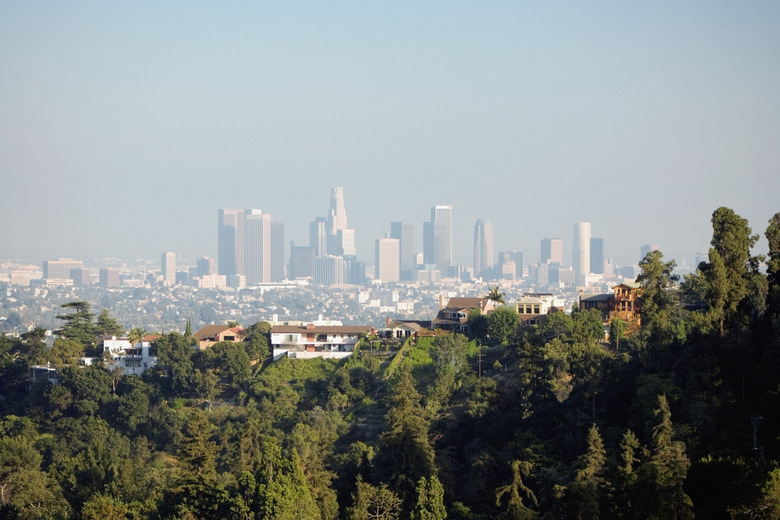Environmental Problems In Los Angeles
The city of Los Angeles, located in southern California, is the third-largest city in North America and the second-largest city in the United States (after New York City). The population of Los Angeles proper is four million people, with a population density of just under 8,500 people per square mile. This heavily populated city – home to Hollywood and renowned for its cultural and ethnic diversity and Mediterranean climate – is also one of the most polluted cities in the United States.
Los Angeles County is home to almost 40 million people and is the most heavily populated county in the United States. The residents of the city of Los Angeles and of Los Angeles County deal with some of the country's worst pollution, primarily air pollution and water pollution.
Major Environmental Issues in Los Angeles
Major Environmental Issues in Los Angeles
The city of Los Angeles faces many environmental problems, including air and water pollution as well as a potentially insufficient municipal water supply. Several factors contribute to this area's disproportionately high levels of environmental pollution, most notably the high population density of Los Angeles city and county. Lack of potable water is a concern, as only 10 percent of water used in Los Angeles is locally sourced.
Air pollution in Los Angeles comes from a number of sources including cars, trucks and industrial manufacturing. These activities can produce smog, which is unsightly and can also damage human health – ozone found in smog is known to have negative effects on the human respiratory system.
Los Angeles Smog
Los Angeles Smog
Smog is a general term used for a mixture of smoke and fog. Smog is relatively common in highly industrial cities such as Los Angeles and Mexico City. Historically, smog has been mainly caused by pollution from coal-burning power plants, but it can also be attributed to pollution caused by vehicles as well as from other industrial sources. Smog can contain ozone, a gas that is helpful for protection from the sun's ultraviolet rays but can be very harmful when inhaled.
Ozone Gas
Ozone Gas
Ozone is an invisible gas made up of three oxygen atoms. Ozone is a naturally-occurring molecule found in Earth's atmosphere, in both the famed ozone layer (located in the stratosphere, between six and 30 miles above Earth's surface) and the troposphere (the part of the atmosphere that is near the ground). Ozone can be created as a result of human activities: The combustion gases created by human activities – from cars, trucks, power plants and factories – react to sunlight exposure, creating ozone molecules.
Ozone has negative impacts on human health. When inhaled, it is known to harm the lungs, inflaming air passages and reducing overall lung function. Inhaling ozone can also worsen asthma and other chronic respiratory diseases. Inhaling ozone gas can harm the lungs of young, healthy individuals as well as infants, the elderly or the infirm.
Storm Water Pollution
Storm Water Pollution
Another major environmental issue affecting Los Angeles is storm water pollution. Storm water pollution is created when trash mixes with rainwater, creating a "toxic soup" that flows untreated into waterways like rivers and streams and can trash entire neighborhoods. Storm water pollution typically contains refuse such as cigarette butts, pet waste, trash, pesticides, motor oil and industrial waste that has been thrown on the ground or deposited directly into storm drains.
Storm water pollution creates unsanitary living conditions and results in unhealthy surface waters in local lakes, creeks and rivers. It creates a public health risk to residents of Los Angeles during and after a rain event.
It is recommended that people and animals avoid contact with contaminated water for up to three days after rainfall ends. Contact with or swimming in contaminated water – especially within 400 yards of a storm drain outlet – can result in a variety of health conditions, including viral infection, skin rashes, sinus problems, earache, fever and viral diseases such as hepatitis.
Land Use Incompatibility
Land Use Incompatibility
Los Angeles residents are also dealing with the negative results of land use incompatibility. Land use incompatibility refers to the practice of placing two incompatible properties next to each other – for example, placing a polluting factory next to a school or hospital.
In southeastern Los Angeles it is estimated the one-fifth of residents live adjacent to land that houses a noxious polluting facility. These residents are exposed to toxic pollution on a regular basis and have much shorter life expectancies than people who don't live next to a toxic facility.
Los Angeles is known for having a high number of urban oil extraction sites, many of which are located next to homes, schools and hospitals. Oil extraction sites are known to use large amounts of toxic industrial chemicals in their process – including some known carcinogens and endocrine disruptors. Los Angeles residents who live next to urban oil extraction sites have experienced negative health effects such as nosebleeds, headaches, dizziness and nausea, in addition to the constant noise and bad odors emanating from the oil drilling sites.
References
- LA Times: EPA Urged to Tighten Ozone Standards
- Southern California Public Radio: Water, Transit and Toxic Hotspots Are among Environmental Issues Awaiting LA's Next Mayor
- State of California: Indicators of Climate Change in California
- California Environmental Protection Agency: Storm Water Pollution
- Physicians for Social Responsibility – Los Angeles: Air & Climate Justice
- US Environmental Protection Agency: What is Ozone?
- National Geographic: Smog
Cite This Article
MLA
Reinbold, Joan. "Environmental Problems In Los Angeles" sciencing.com, https://www.sciencing.com/environmental-problems-in-los-angeles-12504827/. 30 September 2021.
APA
Reinbold, Joan. (2021, September 30). Environmental Problems In Los Angeles. sciencing.com. Retrieved from https://www.sciencing.com/environmental-problems-in-los-angeles-12504827/
Chicago
Reinbold, Joan. Environmental Problems In Los Angeles last modified August 30, 2022. https://www.sciencing.com/environmental-problems-in-los-angeles-12504827/
